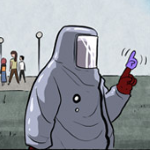|
This Giant X-Ray Generator Helped Set Safe Doses for Radiationquote:“The only single documented whole body exposure that I know that I’ve had was in 1929, and it was measured to be 150 [Roentgen]…. I sat in an X-ray beam for 20 minutes or half an hour or something…. I was just sitting right smack in the beam…. [With that much radiation] you’re supposed to get nauseated, but we didn’t know that in 1929, so I wasn’t.” 
|
|
|
|

|
| # ? Jun 8, 2024 18:59 |
|
I've always thought radiation was way less dangerous than people thought it was 
|
|
|
|
Moist von Lipwig posted:I've always thought radiation was way less dangerous than people thought it was It is and it isn't. It's not some all-destroying force that is deadly in even tiny exposures.There was a freakout after Fukushima about the radioactives released into the Pacific Ocean. Any additional pollution is bad, especially radioactive, but the increase in the existing level of background radiation was minuscule. People wonder why the dentist and her assistant leave the room entirely while you're supposed to be "safe" with a lead apron. The apron is really effective, but you still get a little. And it adds up over a lifetime, radiation is increasingly harmful in cumulative doses. Your X-ray tech could get your lifetime exposure hundreds or thousands of times over their career, so they have to absolutely minimize their exposure every time they take an X-ray. And it works, they're safe from building up to a dangerous cumulative dose. Then there are the immediately lethal events. These take very high doses to kill you. Not instantly. The Demon Core for example, that was a 14 pound lump of refined plutonium (only 3.5 inches across !). Harry Daghlian was killed by a brief flash of supercriticality after dropping a moderator brick. His last contribution to science was the study of his symptoms in the 25 days it took him to die. Another nasty one was what happened to the Radium Girls. Short version, licking a brush to sharpen the point is a really bad idea when you're using glow-in-the-dark radium paint. That case lead to serious advances in labor health and safety regulations. So radiation is dangerous, but unless you're around an uncommonly high source, panic is not indicated.
|
|
|
|
Reading some of the IAEA reports on radiation accidents is illuminating (  ) to say the least. The one about the 3 guys who slept next to an active RTG because it was cold and they could feel the heat was fairly sad, or the thieves in Brazil that stole a Cesium core and exposed a few thousand people to unhealthy doses was another sad one. ) to say the least. The one about the 3 guys who slept next to an active RTG because it was cold and they could feel the heat was fairly sad, or the thieves in Brazil that stole a Cesium core and exposed a few thousand people to unhealthy doses was another sad one.
|
|
|
|
There's still a lot of debate about what the minimum dose that can cause cancer is. A lot of our data comes from animal studies or lifetime studies of nuclear bomb survivors and we have a decent idea of what happens at substantial doses, but it's really difficult to do cancer studies on very low doses. In theory all it takes is a single gamma photon can rip through a cell's DNA and give you cancer 20 years down the road but that's something that's exceedingly difficult to test. Because of that a lot of health physicists take a safe and conservative view that any radiation exposure increases the risk of cancer down the road. However, so far it seems that low doses above background (medical imaging, safe handling of radiation technology, etc.) don't increase the relative risk (risk above and beyond non-exposed groups) enough to worry about. Exposure to excess radiation should be avoided if possible or if there isn't a good reason for it, of course, but tiny doses aren't all that worth worrying about. The public doesn't understand this because they haven't been studying as a healthy physicist like me, and so they freak the gently caress out when someone raises the alarm about water off the west coast of North America has detectable (on the order of fractions of a becquerel per litre) radioisotopes from Fukushima. Not that Fukushima was any good, but if it posed a substantial risk to us over here then why is anyone still even alive in Japan?
|
|
|
|
Icon Of Sin posted:Reading some of the IAEA reports on radiation accidents is illuminating ( There are some good ones from sterilisation facilities where it turns out if your machine is old and rickety people get really blasé about boring things like "safety interlocks" when the trolleys get stuck for the hundredth time
|
|
|
|
BattleMaster posted:There's still a lot of debate about what the minimum dose that can cause cancer is. A lot of our data comes from animal studies or lifetime studies of nuclear bomb survivors and we have a decent idea of what happens at substantial doses, but it's really difficult to do cancer studies on very low doses. In theory all it takes is a single gamma photon can rip through a cell's DNA and give you cancer 20 years down the road but that's something that's exceedingly difficult to test. Because of that a lot of health physicists take a safe and conservative view that any radiation exposure increases the risk of cancer down the road. Aren't there studies of people who live in places with above-normal radioactivity in groundwater, or suchlike? I remember hearing about places that have had, like dissolved radium in their water for thousands of years.
|
|
|
|
Zemyla posted:Aren't there studies of people who live in places with above-normal radioactivity in groundwater, or suchlike? I remember hearing about places that have had, like dissolved radium in their water for thousands of years. Ramsar, Iran is possibly the best example. Flats built with contaminated steel in I think it was Taiwan made another good study.
|
|
|
|
I spent a few months in Aberdeen Scotland because I was working in the oil industry. Some of my geologist coworkers were talking about how much background radiation is present in the city. The old buildings are made out granite that have some residual radioactivity and nearby there is some radium that is trapped underground,
|
|
|
|
Zemyla posted:Aren't there studies of people who live in places with above-normal radioactivity in groundwater, or suchlike? I remember hearing about places that have had, like dissolved radium in their water for thousands of years. It's true that there are places with much higher levels of background than others, and that the yearly dose you accrue from being in such a place can be quite high. However it's also well established that dose rate is incredibly important in determining risk even when talking about the same total dose. 10 mSv all at once from medical imaging will have a much greater risk associated with it than 10 mSv per year from that one place in Iran. There's still a lot of debate over specifically how much of a risk is involved from doses that are that low, though. There probably is a risk but there's a lot of uncertainty when trying to quantify it. The data we have on cancer in humans caused by low doses of radiation kind of sucks. There's often high uncertainty in the doses people receive because the average person doesn't carry a dosimeter with them. Also, when you're talking about 20 year-ish lead times on cancers it's difficult to separate all other risk factors from just that caused by radiation. It's not like acute radiation syndrome where someone can be blasted and show symptoms with a clear causal link within days. Because of this uncertainty there is debate in what the dose-risk relationship looks like. Some people believe that there's actually a lower limit on exposure before a risk manifests itself, and a smaller group of people believe that low doses are actually good for you for some reason that hasn't been determined yet. But I think it's just safer to assume that the risk increases with dose no matter how low that dose is. Even then, there's no reason to freak out over tiny risks like a plume of radioisotopes from Fukushima that has been diluted down to essentially nothing as it traveled the entire length of the Pacific. BattleMaster has a new favorite as of 05:30 on Apr 30, 2017 |
|
|
nmfree posted:This Giant X-Ray Generator Helped Set Safe Doses for Radiation Penetrating whole body gamma =! X-ray tight beam. That paragraph is very misleading. BattleMaster posted:But I think it's just safer to assume that the risk increases with dose no matter how low that dose is. Even then, there's no reason to freak out over tiny risks like a plume of radioisotopes from Fukushima that has been diluted down to essentially nothing as it traveled the entire length of the Pacific. Hence why linear no threshold is the accepted risk assessment for people who work with tangible radiation sources. Sure it might be more conservative than really required but you can't know. Plus by taking that viewpoint in a professional environment you can plan requirements to control individual exposure, which is very difficult for natural exposure.
|
|
|
|
|
mllaneza posted:And it adds up over a lifetime, radiation is increasingly harmful in cumulative doses. Your X-ray tech could get your lifetime exposure hundreds or thousands of times over their career, so they have to absolutely minimize their exposure every time they take an X-ray. And it works, they're safe from building up to a dangerous cumulative dose. Someone should tell Kim Jong-Un that he can make himself immune to US nukes by taking small doses of radiation every day, like a modern-day Mithridates.
|
|
|
|
F hole posted:The old buildings are made out granite that have some residual radioactivity and nearby there is some radium that is trapped underground,
|
|
|
|
I was recently reading a paper about low dose, longer run chemotherapy with cytotoxic alkylating agents. Is it possible that low to moderate dose radiation could have the same effect? Damaging the fastest growing cancer cells beyond their ability to repair and eventually causing apoptosis without causing undue damage to the slower growing cells elsewhere except the gut?
|
|
|
|
The Goiania incident in Brazil is sad, but also darkly hilarious because the only security guard on duty that day called out sick to go see Herbie Goes Bananas.
|
|
|
|
M_Gargantua posted:Penetrating whole body gamma =! X-ray tight beam. Moist von Lipwig posted:I was recently reading a paper about low dose, longer run chemotherapy with cytotoxic alkylating agents. Is it possible that low to moderate dose radiation could have the same effect? Damaging the fastest growing cancer cells beyond their ability to repair and eventually causing apoptosis without causing undue damage to the slower growing cells elsewhere except the gut? It should be noted that the gap in knowledge below 300msv is because the statistics just don't work with the amount of people receiving medical doses in that range and it would be unethical to expose enough people to make the statistics work. The cancerous cells targeting has been proposed as a reason why LNT falls apart there but there just isn't the info to say yes or no. <50msv is well established as in the indistinguishable from noise part of LNT by airline pilots, >300 is established as linear as all hell by the studies on Japanese nuclear bomb survivors and the space in between doesn't really matter because it's just a range noone is exposed to often enough to characterize.
|
|
|
|
mllaneza posted:Then there are the immediately lethal events. These take very high doses to kill you. Not instantly. I've never heard of someone getting enough ionizing radiation to instantly kill them. Some of the nastier criticality excursions like Cecil Kelley left the victim stunned and confused, with pain, nausea, and bleeding, but they usually recover enough to explain what happened and say their goodbyes. There seems to be a pretty big window of you're-hosed-ness where increasing amount of exposure doesn't much change the outcome, it's still going to be a few hours of walking ghost then death in 24-48 hours due to an absence of bone marrow. AFAIK a high enough level of exposure to drop someone in their tracks would cause death by brain hemorrhage as structural proteins broke down and the blood/brain barrier started leaking, but by that point the victim is literally being cooked. That's one reason the "neutron bomb" was not a very useful battlefield weapon, tank crews are so well shielded from NBC and blast damage that even a direct hit by an enhanced radiation tactical nuke would not take out an entire Soviet tank column, at least not right away. Some of them would survive and the crews would be able to keep fighting for at least another few hours. Syd Midnight has a new favorite as of 17:13 on Apr 30, 2017 |
|
|
|
Syd Midnight posted:That's one reason the "neutron bomb" was not a very useful battlefield weapon, tank crews are so well shielded from NBC and blast damage that even a direct hit by an enhanced radiation tactical nuke would not take out an entire Soviet tank column, at least not right away. Some of them would survive and the crews would be able to keep fighting for at least another few hours. That reminds me -- in the past I heard the neutron bomb described as a weapon that "kills people but leaves buildings standing". But wouldn't everything near the blast site be hopelessly radioactive due to neutron activation?
|
|
|
|
It's a dreamy idea born from no real-world results other than "that new radiation thing sure looks scary!". Basically a fantasy weapon powered by Unobtainium.
|
|
|
|
ToxicFrog posted:That reminds me -- in the past I heard the neutron bomb described as a weapon that "kills people but leaves buildings standing". But wouldn't everything near the blast site be hopelessly radioactive due to neutron activation? I wouldn't say hopelessly radioactive, it's really going to depend on the materials present in the area. Plus, it's not like buildings in the target area would still exist (even the smallest manufactured neutron bomb still packs a kiloton yield of actual explosion) unless they were reinforced. Outside of the impact area but still within the potentially lethal zone buildings would survive, but if those building walls are sufficiently thick nobody in them is dying. Honestly the problem with neutron bombs is that unless you salt them they're just not that useful, the radiation isn't enough to kill tank crews unless you drop a half dozen, they demolish civilian buildings in the area hit with the most neutrons, and the bombs are relatively 'clean' in that they produce little fallout as the bomb casings are designed to not capture neutrons. It also doesn't help that the bombs eat tritium like crazy even when they're sitting in stockpile.
|
|
|
|
So you're telling me Kill The Poor is not a scientifically accurate song?
|
|
|
|
Syd Midnight posted:I've never heard of someone getting enough ionizing radiation to kill them immediately. I think he was saying that the instant you get the dose, you are dead. You may keep talking and walking around for a few days or weeks, but you are already terminal. I mean you go on to basically back up what I thought he was saying, but in retrospect his use of the word 'immediate' is a very ambiguous in that context. Proteus Jones has a new favorite as of 15:23 on Apr 30, 2017 |
|
|
|
Syd Midnight posted:That's one reason the "neutron bomb" was not a very useful battlefield weapon, tank crews are so well shielded from NBC and blast damage that even a direct hit by an enhanced radiation tactical nuke would not take out an entire Soviet tank column, at least not right away. Some of them would survive and the crews would be able to keep fighting for at least another few hours. That was the whole point of the neutron bomb (well, one of them): You've got to keep in mind that the ideas for the weapon date back to the 1960s, before composite armor, and 10 centimeters or so of steel look pretty much like a window to a 14 MeV neutron. A one-kiloton bomb going off would result in lethal exposure to every tank crew within a half mile sufficient to incapacitate within a few hours. That's pretty effective. Later composite armor incorporating hydrogenous materials were developed that incidentally (or not) provided significantly enhanced protection against neutron radiation, but that postdated the weapons themselves. Note that they were also used in early ABM programs, where the burst of neutrons would predetonate the incoming warhead and ruin its yield. ToxicFrog posted:That reminds me -- in the past I heard the neutron bomb described as a weapon that "kills people but leaves buildings standing". But wouldn't everything near the blast site be hopelessly radioactive due to neutron activation? That description is just inaccurate. "Kills people but leaves buildings standing" was a popular/media misunderstanding, exploited by the politicians to either argue for funding the weapon or to persuade the Europeans whose territory they'd be used on that use of them is acceptable. The bomb is still putting out a sizeable portion of its energy in heat/blast. But 1 kiloton devices are a lot smaller than the 10 kiloton tacnukes they'd have been used instead of. Kwyndig posted:Honestly the problem with neutron bombs is that unless you salt them they're just not that useful, the radiation isn't enough to kill tank crews unless you drop a half dozen, they demolish civilian buildings in the area hit with the most neutrons, and the bombs are relatively 'clean' in that they produce little fallout as the bomb casings are designed to not capture neutrons. It also doesn't help that the bombs eat tritium like crazy even when they're sitting in stockpile. In any situation involving Soviet tank armies rolling into Europe the expectation would have been that we'd be using tens to hundreds of the things, not half a dozen. We built something like 300 W79 warheads for 8" artillery shells, and even more W70 Mod 3s for the Lance missile. Serephina posted:It's a dreamy idea born from no real-world results other than "that new radiation thing sure looks scary!". Basically a fantasy weapon powered by Unobtainium. Not sure where you're getting that. We build hundreds of the things, as did the Soviets. That's hardly unobtanium. Phanatic has a new favorite as of 15:36 on Apr 30, 2017 |
|
|
|
The lethal doses and causes of deaths are: 2.5 Gy, bone marrow damage (hematopoietic syndrome), 30-60 days 10 Gy, intestinal mucosa damage (gastrointestinal syndrome), 3-10 days 100 Gy, neurological and cardiovascular damage (cerebrovascular syndrome), 1-2 days Hematopoietic syndrome can be survivable especially with medical care. The LD50 is about 3.25 Gy without treatment and can been pushed higher (7 Gy documented among serious exposures at Chernobyl, with medical care and antibiotics, but more typical estimates are about 4 or 5 Gy.) 8-10 Gy is going to be pretty bad even with treatment but some data suggests radical treatment lik bone marrow transplants can help in this dose range. Gastrointestinal syndrome is going to kill you because not a whole lot can be done when your gut is killed. At that point you're essentially rotting on the inside. At this dose you're also going to be suffering from screwed up bone marrow but the gut damage kills you faster. The doses that cause cerebrovascular will also damage all of your organs as this is the dose that will even kill non-reproducing, differentiated cells. Your bone marrow and gut will also be screwed up. But it's the cardiovascular and neurological damage that does you in, and much faster than anything else. And at all levels you'll be suffering from all sorts of other cool things like skin damage and depilation and nausea at lower doses all the way up to bloody diarrhea and hypotension at higher doses. As far as I've seen there hasn't been a single case of instant death. Exposure at all of the levels I've talked about cause some immediate symptoms followed by a latent period with no additional symptoms or even the appearance of getting better, followed by a period where the damage catches up with you and serious symptoms manifest. For instance, the latent period for hematopoietic syndrome is because your bone marrow has issues making new blood cells, but your existing blood cells are not harmed. Gastrointestinal syndrome has a delay because your existing villi cells aren't touched but your intestinal stem cells are killed and are no longer producing replacements for when the existing ones slough off. Cerebrovascular syndrome isn't very well understood because only a small number of cases have existed, but even it takes some time to catch up. However, it is accompanied by diarrhea very shortly after exposure. Not death, though, but it sounds like you'll have wished you died faster when the main symptoms appear. Serephina posted:It's a dreamy idea born from no real-world results other than "that new radiation thing sure looks scary!". Basically a fantasy weapon powered by Unobtainium. The pop culture neutron bomb, that is ToxicFrog posted:a weapon that "kills people but leaves buildings standing" is a pure science fiction. Nuclear weapons designed to release more radiation than normal weapons do exist, though. They still have a substantial explosion associated with them (although they are in the kiloton-ish range, keep in mind that the recently-used MOAB has "only" 11 tons TNT equivalent behind it) but can deliver lethal doses for some distance outside of their blast. BattleMaster has a new favorite as of 16:35 on Apr 30, 2017 |
|
|
|
I was reading about radiation poisoning a little while ago and found real life Rad-X (You'll never guess what it's called)
|
|
|
|
flosofl posted:I think he was saying that the instant you get the dose, you are dead. You may keep talking and walking around for a few days or weeks, but you are already terminal. Sorry, my bad, I was agreeing with you but mixed up the words. In his What If? book, Randall Munroe tackles "What if all your DNA suddenly disappeared?" by comparing the scenario to dying from a massive dose of gamma rays, or a few milligrams of amatoxin, since they'd both do a good job turning your cells into incels.
|
|
|
|
I work at an e-waste recycler and to clean up some of our refurbished/used equipment, I've been using a cleaner that came in in a bottle that looks like it's from the 80s. I tried to find more so I could have some at home and I couldn't and it turns out that's because it's full of 1,1,1-trichloroethane, which was banned under the Montreal Protocol 
|
|
|
|
"1,1,1-trichloroethane, also known as methyl chloroform" - wiki
|
|
|
|
All the best solvents got banned for killing the ozone. Its not even excusable like trying to say closed circuit uses like refrigerants are totally closed circuit, you're straight up dumping the stuff out at which point its life cycle is to zoom up and eat an ozone. Which sucks because its dirt simple to do the simple chlorination substitutions to make it and its a case where the fluorinated replacements simply don't have the same solvent properties.
|
|
|
|
Collateral Damage posted:We had/have a similar problem in Sweden, where many houses built before 1975 were built with a type of concrete containing alun shale. Alun shale has a relatively high uranium content, which generates radon gas as part of its decay process. that's an issue anywhere the bedrock contains significant amounts of uranium or thorium (the most common naturally occurring radioactive elements). It's especially common in the northeastern United States and southeastern Canada, where the bedrock is ancient granite and most homes have basements. The tiny bits of thorium in the granite decay and release radon, which builds up in basements to dangerous levels because it's heavier than air. supposedly in some specific areas geological radon is believed to be the second-most common cause of lung cancer, after smoking. This phenomenon was first discovered when an American worker at a nuclear plant started setting off the radiation warning alarms on his way into work. His house was investigated and found to be dangerously radioactive. Also, it's a much bigger issue with modern homes than with older ones. Old houses are drafty, so the radon in the basement is regularly diluted and blown out with clean outside air. Newer, better sealed homes allow the radon to just keep building up for months at a time. Sagebrush has a new favorite as of 18:58 on Apr 30, 2017 |
|
|
|
Natural radioactive granite also causes the first part of rainstorms to show a lot of radioactivity above background, since the dust gets swept out of the air.
|
|
|
|
Sagebrush posted:Also, it's a much bigger issue with modern homes than with older ones. Old houses are drafty, so the radon in the basement is regularly diluted and blown out with clean outside air. Newer, better sealed homes allow the radon to just keep building up for months at a time.
|
|
|
|
Honestly if I ever received a dose of radiation that would kill me within a couple days I'd just find a gun and skip the "excruciating death" part.
|
|
|
|
Luneshot posted:Honestly if I ever received a dose of radiation that would kill me within a couple days I'd just find a gun and skip the "excruciating death" part. Most documented cases of significantly lethal doses were novel enough that nobody was sure what was going to happen to the patient.
|
|
|
|
Yeah, it's a problem in Norway and Sweden as well. Sweden had their own uranium mines for a while, which went well with their dual-use electricity/enriching reactors. In Oslo, we have layers of alum slate, which along with the closely related black slate might well be the worst possible rock to build houses on. It's flaky and not very solid, though at least that makes it easy enough to remove. It expands up to twice the size on contact with air, it contains assorted heavy metals that dissolve easily, it reacts with water to make sulphuric acid, which of course is great both for concrete foundations and for leaching out the previously mentioned heavy metals. Oh, and one of the heavy metals is uranium, so it produces a fair bit of radon gas. Lovely stuff to try and build your foundations in. Did I mention that the sulfur compounds also smell kind of horrible? Computer viking has a new favorite as of 01:32 on May 1, 2017 |
|
|
|
Computer viking posted:alum slate This sounded familiar to the alum block I use as an aftershave, so I went to google a bit more info and found this... uh, thing: http://science.jrank.org/pages/5422/Potassium-Aluminum-Sulfate.html The information seems fairly innocuous, but as you get to the "Citing this material" section and below, it quickly becomes pretty hilarious.
|
|
|
|
Luneshot posted:Honestly if I ever received a dose of radiation that would kill me within a couple days I'd just find a gun and skip the "excruciating death" part. It's ghoulish but I don't think they'd let you because of what could be learned. Health physicists can't do human testing so we need accidents to study.
|
|
|
|
Buff Skeleton posted:This sounded familiar to the alum block I use as an aftershave, so I went to google a bit more info and found this... uh, thing: http://science.jrank.org/pages/5422/Potassium-Aluminum-Sulfate.html quote:You can always be sure you're reading unbiased, factual, and accurate information. Well I wouldn't think people on the internet would be lying. jiangzhuotao in the comments posted:Dear sir/madam, Seems legit.
|
|
|
|
Sagebrush posted:that's an issue anywhere the bedrock contains significant amounts of uranium or thorium (the most common naturally occurring radioactive elements). It's especially common in the northeastern United States and southeastern Canada, where the bedrock is ancient granite and most homes have basements. The tiny bits of thorium in the granite decay and release radon, which builds up in basements to dangerous levels because it's heavier than air. supposedly in some specific areas geological radon is believed to be the second-most common cause of lung cancer, after smoking. My childhood home back in Western Montana was built in the mid 80s and had a radon extractor in the basement. Confused the hell out of me as a kid, because I didn't think radiation could be removed with a simple fan, but apparently the problem is stagnant air causing the radiation to build up over time. Has there been any solid research on fractionated radiation dosage? Supposedly, the DNA damage heals enough between doses to mitigate much of the genetic damage, and it's alleged to have a protective effect over time. Then again, the last person I saw touting it was a crazy Libertarian running for an Oregon congressional seat, so that's not a ringing endorsement.
|
|
|
|

|
| # ? Jun 8, 2024 18:59 |
|
DirtRoadJunglist posted:Has there been any solid research on fractionated radiation dosage? Supposedly, the DNA damage heals enough between doses to mitigate much of the genetic damage, and it's alleged to have a protective effect over time. Then again, the last person I saw touting it was a crazy Libertarian running for an Oregon congressional seat, so that's not a ringing endorsement. It gets statistically messy. Low‐level exposure might be mildly hurtful, mildly beneficial, or have no effect. We really don’t know. The conservative approach is to assume that it’s mildly hurtful and act accordingly, so that’s what we do.
|
|
|





















































